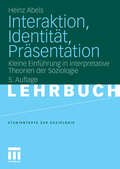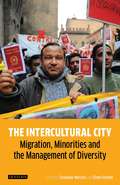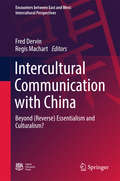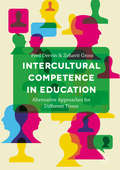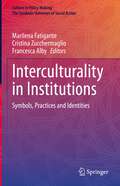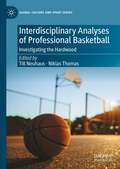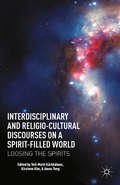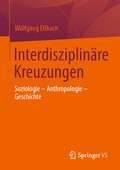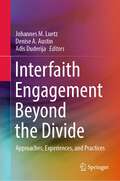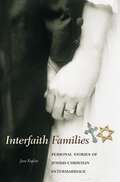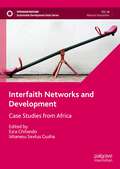- Table View
- List View
Interaktion, Identität, Präsentation: Kleine Einführung in interpretative Theorien der Soziologie (Studientexte zur Soziologie)
by Heinz AbelsDie Einführung macht in verständlicher Sprache mit interpretativen Theorien vertraut. Es werden die wichtigsten Annahmen von George Herbert Mead zum Thema Identität und von Herbert Blumer zur symbolischen Interaktion dargestellt. Anschließend wird die phänomenologische Grundlegung der Soziologie durch Alfred Schütz nachgezeichnet und vor diesem Hintergrund die Theorie der gesellschaftlichen Konstruktion der Wirklichkeit von Peter L. Berger und Thomas Luckmann skizziert. Im letzten Teil werden die Ethnomethodologie nach Harold Garfinkel als eine Theorie des Handelns im Alltag vorgestellt und aus den Arbeiten von Erving Goffman Techniken der Präsentation behandelt.
Interaktion zwischen Spezies: Fremdheit und Nähe (Vital Turn: Leib, Körper, Emotionen)
by Anna K.E. SchneiderWie gestalten sich Mensch-Tier-Interaktionen? Anna Schneider nähert sich dieser Frage gestützt auf Theorien des Symbolischen Interaktionismus, der Philosophischen Anthropologie und Leibphänomenologie sowie verschiedenen Empathiekonzepten. Die Autorin erörtert hierfür ausführlich zwei Fallstudien zur Erkundung von Mensch-Tier-Interaktionen im privaten Umfeld (Mensch-Hund) und im institutionellen Rahmen einer Auffangstation (Mensch-Raubkatze). Sie stellt die speziesübergreifende Interaktion als dialektischen Prozess dar, welcher auf verschiedenen Ebenen vollzogen wird und entscheidend von den Faktoren der Annäherung und Abgrenzung zum Anderen geprägt ist. Die komplexe Methodik und hohe Interdisziplinarität der Arbeit verdeutlicht dabei den Bedarf an innovativen Forschungsmethoden für eine inklusive Mensch-Tier-Forschung und bietet einen theoretischen und methodischen Bezugsrahmen für zukünftige Forschung.
Intercessory Prayer: Modern Theology, Biblical Teaching and Philosophical Thought
by Philip Clements-JeweryHow is prayer possible? How does prayer work? Why is it necessary to ask for God's gifts? Intercessory Prayer attempts to provide answers to questions about the nature of intercessory prayer. Critically examining biblical teaching and modern theological and philosophical thinking, this book shows how intercessory prayer may be seen as one of the means by which God enlists the freely-given cooperation of human persons in the realisation of the divine purpose. Clements-Jewery adopts a process view of the universe to show how intercession both makes certain possibilities greater and strengthens the likelihood of response, so that people who pray may have every confidence that their prayers will make a difference to the world through the God who both influences and is influenced by the creation.
Intercessory Prayer: Modern Theology, Biblical Teaching and Philosophical Thought
by Philip Clements-JeweryHow is prayer possible? How does prayer work? Why is it necessary to ask for God's gifts? Intercessory Prayer attempts to provide answers to questions about the nature of intercessory prayer. Critically examining biblical teaching and modern theological and philosophical thinking, this book shows how intercessory prayer may be seen as one of the means by which God enlists the freely-given cooperation of human persons in the realisation of the divine purpose. Clements-Jewery adopts a process view of the universe to show how intercession both makes certain possibilities greater and strengthens the likelihood of response, so that people who pray may have every confidence that their prayers will make a difference to the world through the God who both influences and is influenced by the creation.
Intercessory Prayer and the Monastic Ideal in the Time of the Carolingian Reforms (Oxford Theology and Religion Monographs)
by Renie S. ChoyIn early medieval Europe, monasticism constituted a significant force in society because the prayers of the religious on behalf of others featured as powerful currency. The study of this phenomenon is at once full of potential and peril, rightly drawing attention to the wider social involvement of an otherwise exclusive group, but also describing a religious community in terms of its service provision. Previous scholarship has focused on the supply and demand of prayer within the medieval economy of power, patronage, and gift exchange. Intercessory Prayer and the Monastic Ideal in the Time of the Carolingian Reforms is the first volume to explain how this transactional dimension of prayer factored into monastic spirituality. Renie S. Choy uncovers the relationship between the intercessory function of monasteries and the ascetic concern for moral conversion in the minds of prominent religious leaders active between c. 750-820. Through sustained analysis of the devotional thought of Benedict of Aniane and contemporaneous religious reformers during the reigns of Charlemagne and Louis the Pious, Choy examines key topics in the study of Carolingian monasticism: liturgical organization and the intercessory performances of the Mass and the Divine Office, monastic theology, and relationships of prayer within monastic communities and with the world outside. Arguing that monastic leaders showed new interest on the intersection between the interiority of prayer and the functional world of social relationships, this study reveals the ascetic ideal undergirding the provision of intercessory prayer by monasteries.
Intercessory Prayer and the Monastic Ideal in the Time of the Carolingian Reforms (Oxford Theology and Religion Monographs)
by Renie S. ChoyIn early medieval Europe, monasticism constituted a significant force in society because the prayers of the religious on behalf of others featured as powerful currency. The study of this phenomenon is at once full of potential and peril, rightly drawing attention to the wider social involvement of an otherwise exclusive group, but also describing a religious community in terms of its service provision. Previous scholarship has focused on the supply and demand of prayer within the medieval economy of power, patronage, and gift exchange. Intercessory Prayer and the Monastic Ideal in the Time of the Carolingian Reforms is the first volume to explain how this transactional dimension of prayer factored into monastic spirituality. Renie S. Choy uncovers the relationship between the intercessory function of monasteries and the ascetic concern for moral conversion in the minds of prominent religious leaders active between c. 750-820. Through sustained analysis of the devotional thought of Benedict of Aniane and contemporaneous religious reformers during the reigns of Charlemagne and Louis the Pious, Choy examines key topics in the study of Carolingian monasticism: liturgical organization and the intercessory performances of the Mass and the Divine Office, monastic theology, and relationships of prayer within monastic communities and with the world outside. Arguing that monastic leaders showed new interest on the intersection between the interiority of prayer and the functional world of social relationships, this study reveals the ascetic ideal undergirding the provision of intercessory prayer by monasteries.
Interconnectivity, Subversion, and Healing in World Christianity: Essays in honor of Joel Carpenter
by Touraj AtabakiThe rise of Christianity around the world has been the impetus for much religious and social change. The interconnectivity of religious centers has resulted in theological dialogue and innovation. The subversion of long-held categories of culture, gender, race, spirituality, theology, and politics has naturally occurred along with the transgressing of borders and boundaries. Yet at the same time, there has been occasion for healing through intercultural experiences of forgiveness, peacemaking, and reconciliation.Stimulated by the work and mentorship of Joel Carpenter, who has done much to expand the study of world Christianity less through focusing on his own research and writing, and more through amplifying the voices of others, the international contributors to this volume from all six continents promote a deeper understanding of World Christianity through the exploration of such related themes.Whether discussing primal spirituality in northeast India, white supremacy in South Africa, evangelical women and civic engagement in Kenya, or Calvinism in Mexico, the contributors draw upon ethnographic case studies to more deeply understand interconnectivity, subversion, and healing in World Christianity. Their essays provoke a reorientation of Christian thought within the study of World Christianity, enriching the current discourse and promoting vistas for further interdisciplinary studies.
Interconnectivity, Subversion, and Healing in World Christianity: Essays in honor of Joel Carpenter
The rise of Christianity around the world has been the impetus for much religious and social change. The interconnectivity of religious centers has resulted in theological dialogue and innovation. The subversion of long-held categories of culture, gender, race, spirituality, theology, and politics has naturally occurred along with the transgressing of borders and boundaries. Yet at the same time, there has been occasion for healing through intercultural experiences of forgiveness, peacemaking, and reconciliation.Stimulated by the work and mentorship of Joel Carpenter, who has done much to expand the study of world Christianity less through focusing on his own research and writing, and more through amplifying the voices of others, the international contributors to this volume from all six continents promote a deeper understanding of World Christianity through the exploration of such related themes.Whether discussing primal spirituality in northeast India, white supremacy in South Africa, evangelical women and civic engagement in Kenya, or Calvinism in Mexico, the contributors draw upon ethnographic case studies to more deeply understand interconnectivity, subversion, and healing in World Christianity. Their essays provoke a reorientation of Christian thought within the study of World Christianity, enriching the current discourse and promoting vistas for further interdisciplinary studies.
The Intercultural City: Migration, Minorities and the Management of Diversity (International Library Of Human Geography Ser.)
by Giovanna Marconi Elena OstanelCities around the world are facing increasingly diverse populations as a result of migration, both from rural areas within their own national borders and from other countries. The resulting cultural differences can often create problems and conflict. In Europe alone, the sheer scale of migration is forcing the issue to the top of the political agenda. The Intercultural City brings together scholars from a range of disciplines – including urban studies, geography, planning, sociology, political science and spatial design – to explore both the failings of existing policies to manage diversity and to examine how one might begin to create ways to remove obstacles and enhance the integration of migrants and minorities. Combining fresh theoretical insights with studies from cities in Europe, North America, Asia and Africa, The Intercultural City offers a timely and important contribution to the challenge of managing diversity in the city of the twenty-first century.
Intercultural Communication with China: Beyond (Reverse) Essentialism and Culturalism? (Encounters between East and West)
by Fred Dervin Regis MachartA major objective of this book is to identify the key determinants of the “East” and the “West” in the field of intercultural communication. It examines but also counter-attacks essentialist and culturalist analyses of intercultural communication between China and the rest of the world. Offering a cross-country examination and comparison of drought awareness and experience, this book shows two fields of research, which are complementary but rarely found side by side, i.e. the Arts and Intercultural Encounters, serve as illustrations for theoretical and methodological discussions about intercultural communication between China and the West. Scholarly and media discourses will find this work thought-provoking, instructive and informative.
Intercultural Competence in Education: Alternative Approaches for Different Times
by Fred Dervin Zehavit GrossThis book explores the concept of intercultural competence, focusing specifically on education. Intercultural competence can vary depending on the field of research or the context of application and has therefore developed over recent decades. As the world becomes increasingly global intercultural competence has become even more important but it is still not practiced satisfactorily. This book highlights views which are at odds with official and orthodox positions on intercultural competence to encourage fresh approaches to intercultural competence. It will be invaluable for researchers, practitioners and students interested in the global possibilities of education.
Intercultural Education: Ethnographic and Religious Approaches
by Eleanor NesbittThis book has been written for teachers, teacher trainers and their students, and others working with children and young people. It provides a valuable resource for those engaged in religious studies and South Asian studies, comprising a rich library of data relevant to current debates in these fields. Drawing on field studies of children of South Asian and other backgrounds in Britain, Nesbitt argues the value to schools of teachers adopting an ethnographic approach in intercultural education. Examples from primary, secondary and higher education demonstrate the urgent need for teachers and others to be better informed of cultural diversity and to understand the interconnections between ethnographic studies, pastoral care, the curriculum, and international events. "Intercultural Education" examines a wide variety of issues, including spirituality, identity formation, the ways in which beliefs' and practices' are represented, stereotyping communities, being a Christian at school, and the role of caste. The book contains Practical Guidelines for teachers, as well as a Glossary, covering pastoral care, racism, liaison with parents, recognising the diversity of language, etc.
Intercultural Phenomenology: Playing with Reality (Bloomsbury Introductions to World Philosophies)
by Yuko Ishihara Steven A. TainerIntercultural Phenomenology explores the nature of reality by engaging in a cross-cultural dialogue between two of the most influential philosophical traditions of the 20th century. Drawing on ideas from phenomenology, Japanese philosophy and Zen Buddhism, it follows the philosophers who changed their perception of the world by choosing to suspend judgement. Guided by this philosophical method known as the “epoché”, or suspension of judgment in ancient Greek, it is an introduction to the philosophy and practice of letting objects in the world speak for themselves. Inspired by Nishida Kitaro's insight that true reality is beyond the subject-object duality, the book uses a series of examples and exercises to explore the background to Husserl's idea of the phenomenological epoché, Hans-Georg Gadamer's emphasis on play in human understanding and the haiku poet Matsuo Basho's call for a new level of freedom. This practice-oriented approach moves beyond the traditional East-West divide. It connects various traditions, old and new, contemplative and theoretical, and explains why Japanese philosophy and phenomenology can enrich the quality of our lived experience.
Intercultural Phenomenology: Playing with Reality (Bloomsbury Introductions to World Philosophies)
by Yuko Ishihara Steven A. TainerIntercultural Phenomenology explores the nature of reality by engaging in a cross-cultural dialogue between two of the most influential philosophical traditions of the 20th century. Drawing on ideas from phenomenology, Japanese philosophy and Zen Buddhism, it follows the philosophers who changed their perception of the world by choosing to suspend judgement. Guided by this philosophical method known as the “epoché”, or suspension of judgment in ancient Greek, it is an introduction to the philosophy and practice of letting objects in the world speak for themselves. Inspired by Nishida Kitaro's insight that true reality is beyond the subject-object duality, the book uses a series of examples and exercises to explore the background to Husserl's idea of the phenomenological epoché, Hans-Georg Gadamer's emphasis on play in human understanding and the haiku poet Matsuo Basho's call for a new level of freedom. This practice-oriented approach moves beyond the traditional East-West divide. It connects various traditions, old and new, contemplative and theoretical, and explains why Japanese philosophy and phenomenology can enrich the quality of our lived experience.
Interculturality in Institutions: Symbols, Practices and Identities (Culture in Policy Making: The Symbolic Universes of Social Action)
by Marilena Fatigante Cristina Zucchermaglio Francesca AlbyThis book provides qualitative analyses of intercultural sense making in a variety of institutional contexts. It relies on the assumption that in an increasingly culturally diverse world, individuals often enter contexts that have communal, historically determined and stable sets of values, norms and expected identities, with little cultural compass to find their bearings in them. The book goes beyond interpreting differences in people’s ethnic or linguistic roots and discusses instead people’s interpretive efforts to navigate different sociocultural situations. The contributors examine such situations in educational, organizational, medical and community settings and look at how participants with different levels of sociocultural competences (such as, migrant patients, migrant adult learners, children) try to cope with institutional constraints and expectations, how they understand symbols, practices and identities in institutional contexts, and how their creative adjustments come to light. This book provides insights from the fields of psychology, education, anthropology and linguistics, and is for a wide readership interested in cultural meaning-making.
Interdisciplinary Analyses of Professional Basketball: Investigating the Hardwood (Global Culture and Sport Series)
by Till Neuhaus Niklas ThomasThis edited collection conceptualizes professional basketball not just as a sport but as an historically, culturally, and economically embedded entity. The chapters analyse the fact that the sport of basketball contains alternative logics that can easily clash, and by treating professional basketball as the negotiation place of these multiple demands, ideas, and logics, the editors have identified three areas in which these clashes manifest: the realization of the game; the cultural impact of professional basketball and the global outreach of professional basketball. The book is explanatory and qualitative, offering new perspectives and touching on topics including gender, diversity, racism, and minority experiences within professional basketball. As such it will be of interest to sport sociologists, as well as those researching the history of sport, sports marketing and cultural studies.
Interdisciplinary and Religio-Cultural Discourses on a Spirit-Filled World: Loosing the Spirits
by Veli-Matti K�rkk�inen, Kirsteen Kim, and Amos YongThis volume presents interdisciplinary, intercultural, and interreligious approaches directed toward the articulation of a pneumatological theology in its broadest sense, especially in terms of attempting to conceive of a spirit-filled world.
Interdisziplinäre Kreuzungen: Soziologie – Anthropologie – Geschichte
by Wolfgang EßbachDie Aufforderung, über den Tellerrand des eigenen Faches hinauszuschauen, die Einsicht, daß sich nicht unbedingt im Zentrum, sondern an den Rändern von Fächern neuartige Fragen stellen, und die Klagen über den Fachidiotismus sind wohlbekannt. Der geflügelte Spruch des Dichters Jean Paul: „Jeder Fachmann ist in seinem Fach ein Esel“ trifft auch Nur-Soziologen, die nichts von ihrem Fach wissen, wenn sie sich nicht in der Landschaft auskennen, die ihre Disziplin umgibt. Ihre späte Akademisierung hat der Soziologie eine schöne Vielfalt von angrenzenden Nachbarschaften beschert. Dieser Band handelt von Kreuzungen zwischen Soziologie, Anthropologie und Geschichte. In den Studien geht es unter anderem um historische Quellen soziologischen Denkens, um die Erforschung von Biografien, um kulturelle Identität und Migration, die Problemgeschichte der Anthropologie, um Gabe und Rache, um den Ort der Phänomenologie in der Soziologie und Anthropologie artifizieller Lebenswelt, um Postmoderne als Gegenwart oder Epoche, die Begrenzungen des Historismus, das Verhältnis von Subjektivierungsweise und Geschichte, die soziale Funktion von Vergangenheitsrepräsentation und die Frage: Welche Vergangenheit brauchen unsere Kinder?Der Band versammelt Schriften Wolfgang Eßbachs zum inter- und transdisziplinären Verhältnis von Soziologie, Anthropologie, Geschichte und wie sie sich gegenseitig befruchten können.
Interested Parties: The Ideology of Writers and Readers of the Hebrew Bible (The Library of Hebrew Bible/Old Testament Studies)
by David J. ClinesOne of the more creative Old Testament scholars of our time, David Clines offers an enjoyable and provocative set of studies on ideology. The title of a keynote essay, 'Why is There a Song of Songs, and What Does It Do to You If You Read It?', hints at the twin focus of the volume: the ideology of the writers, who bring the biblical texts into being, and the ideologies of the readers, who are shaped by the text at the same moment as they are shaping it in their own image. Among the essays are 'The Ten Commandments, Reading from Right to Left'; 'Metacommentating Amos'; 'David the Man: The Construction of Masculinity in the Hebrew Bible'; and 'Psalm 2 and the MLF (Moabite Liberation Front)'.
Interfaith Dialogue: Global Perspectives (Pathways for Ecumenical and Interreligious Dialogue)
by Edmund Kee-Fook ChiaThis book addresses issues central to today’s Catholic Church, focusing on the relationship between various religions in different contexts and regions across the world. The diverse array of contributors present an inclusively interfaith enterprise, investigating a wide range of encounters and perspectives. The essays include approaches from the Jewish, Muslim, Buddhist, and Bahá’í traditions, in a variety of geographic contexts. Contributors reflect on Muslims in the West, Christian-Buddhist social activism, and on Chinese, Indian, and Japanese religions. The volume also explores the experiences of communities that are often marginalized and overlooked such as the Aborigines and Torres Strait Islanders of Australia and the Karen tribal peoples of Thailand. Contributors examine the works of the Focolare, Gülen, and Risshō Kōsei-kai movements, and integrate the vision of Raimon Panikkar and Ken Wilber. Chapters incorporate discussions of dialogue documents such as Nostra Aetate and Dabru Emet, and methodologies such as Receptive Ecumenism, Comparative Theology, and Scriptural Reasoning. Among other goals, the book seeks to offer glimpses into interfaith dialogues across the world and examine what Christians can learn from other religions and global contexts.
Interfaith Engagement Beyond the Divide: Approaches, Experiences, and Practices
by Johannes M. Luetz Denise A. Austin Adis DuderijaThis book features reflections by scholars and practitioners from diverse religious traditions. It posits that the global challenges facing humanity today can only be mastered if humans from diverse faith traditions can meaningfully collaborate in support of human rights, reconciliation, sustainability, justice, and peace. Seeking to redress common distortions of religious mis- and dis-information, the book aims to construct interreligious common ground ‘beyond the divide’.Organised into three main sections, the book features sixteen conceptual, empirical, and practice-informed chapters that explore spirituality across faiths and cultures. Chapter 1 delineates the state of the art in relation to interfaith engagement, Chapters 2–8 advance theoretical research, Chapters 9–12 discuss empirical perspectives, and Chapters 13–16 showcase field projects and recount stories and lived experiences.Comprising works by scholars, professionals, and practitioners from around the globe, Interfaith Engagement Beyond the Divide: Approaches, Experiences, and Practices is an interdisciplinary publication on interreligious thought and engagement:Assembles a curated collection of chapters from numerous countries and diverse religious traditions;Addresses interfaith scholarship and praxis from a range of interdisciplinary perspectives;Comprises interfaith dialogue and collaborative research involving authors of different faiths;Envisions prospects for peace, interreligious harmony in diversity, and a world that may be equitably and enduringly shared.The appraisal of present and future challenges and opportunities, framed within a context of public policy and praxis, makes this interdisciplinary publication a useful tool for teaching, research, and policy development. Chapter 16 is available open access under a Creative Commons Attribution 4.0 International License via link.springer.com.
Interfaith Families: Personal Stories of Jewish-Christian Intermarriage
by Jane KaplanChristmas or Hanukkah? Bris or baptism? Church or synagogue? As the number of Jewish-Christian marriages in America continues to rise, couples find themselves searching for ways to navigate the choppy waters of interfaith families. Children, extended family, and communities can all contribute to the strain a marriage might feel when religion is an issue. Should the children be raised in one faith and not the other? Who should decide which holidays to celebrate and how? How can couples deal with extended family members who may not understand or accept the interfaith marriage? Here, couples in Jewish-Christian marriages describe their experiences and reveal intimate details of their lives as members of these unique families. Without being prescriptive, this book offers examples of the successes and failures, struggles and triumphs of such religiously mixed families, shedding light on new ways to approach everyday situations and major life decisions.The couples whose stories are found in these pages describe how they tackled these topics. Many decided to maintain a Jewish household, while others decided on a Christian family life. Still others found ways to incorporate both religions, and in some cases one partner converted to the other's faith. In all situations, the couples describe their sacrifices, feelings, frustrations, and religious behaviors and practices. Readers will find an array of reactions and approaches in these pages, and will come away with fresh insight into interfaith families in general and Jewish-Christian marriage in particular.
Interfaith Just Peacemaking: Jewish, Christian, and Muslim Perspectives on the New Paradigm of Peace and War
by Susan Brooks ThistlethwaiteInterfaith Just Peacemaking is a collected work by 27 Jewish, Muslim and Christian scholars and religious leaders on the ten 'practice norms' of the peacemaking paradigm called 'Just Peace.'Just Peace theory, like the paradigm it most resembles, Just War theory, is a list of specific practices that are applied to concrete contexts.
Interfaith Marriage in America: The Transformation of Religion and Christianity (Christianities of the World)
by E. SeamonSeamon explores the historical, theological, and societal dynamics of religious intermarriage as a way to introduce scholars to the myriad of factors that have contributed and will continue to contribute to the complete transformation of religion and Christianity in the twenty-first century.
Interfaith Networks and Development: Case Studies from Africa (Sustainable Development Goals Series)
by Ezra Chitando Ishanesu Sextus GushaAlthough there is growing interest in the role of religion in meeting the United Nations Sustainable Development Goals (SDGs), Agenda 2030, very few studies have focused on the contributions of interfaith networks. Most of the contemporary publications on religion and development focus on single religions or faith-based organizations. This volume addresses the lacuna in the available scholarship by undertaking detailed analyses of how interfaith networks in diverse African contexts contribute to development. Chapters in this volume engage in theoretical debates on interfaith networks and development, while describing concrete, fresh case studies on how particular interfaith networks are contributing towards the meeting of the SDGs in specific contexts. Thus, the volume describes older and newer interfaith networks and analyses their achievements and challenges. Contributors focus on SDGs that include peacebuilding, gender, youth, the environment, as well as overviews of interfaith initiatives in different African contexts.
